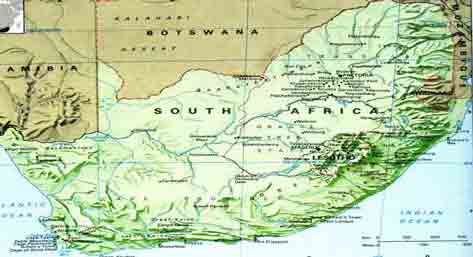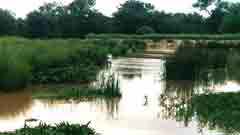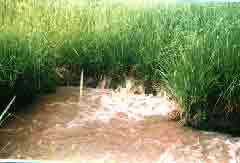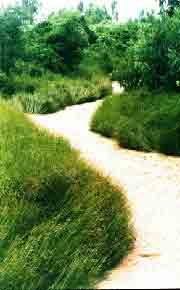
When the historians of the
future look back at soil and water conservation developments of our era, unassuming people
with names such as Sue Hart, Francis Mbuka, Mathews Munda, Tony Tantum, Jano Labat,
Stephen Carr, Malcom Blackie, and Glenn Allison will, amongst others, be remembered for
introducing the modern vetiver grass hedge technology to southern Africa countries. These
men and women, all with strong agricultural and environmental backgrounds and convictions,
and deep understanding of Africa, knew the need for low cost conservation systems that
require little maintenance. They also were aware of the failure and high cost of more
traditional systems. They are an ingenious and innovative lot, who were able to recognize
the uniqueness of Vetiver grass its use. Most importantly, they and a growing number of
southern Africans, were committed to share their successes with others. This is their
story.
South Africa
There are two species of vetiver grass in South Africa, Vetiveria nigratana, an indigenous
grass, found mainly in some river systems that are linked to the Okavambo swamps, and
Vetiveria zizanioides, introduced from Mauritius to the Province of Kwa Zulu/Natal as
early as 1860. It is this species that is now being used by Tantum and others for soil and
water conservation and land stabilization. It is believed that in the 1940s a Frenchman
initiated a long forgotten vetiver based conservation program in an area south of Durban,
remnants of which exist some 50 years later, although current generations don't know why
it was planted!! Importantly what we do know today (thanks to the Vetiver Identification
Program) is that the Vetiveria zizanioides used all over South Africa today is genetically
identical to Monto Vetiver of Queensland, Australia, Sunshine Vetiver of Louisiana, USA,
and the oil producing vetivers of Mauritius and south India. It is also identical to
vetivers from Guatemala and Fiji All these vetivers are sterile and non invasive, and can
only be propagated by plant division. The Australian Government only recently approved the
release of Monto Vetiver to the public after six years of intensive and controlled site
investigations by Paul Truong.
Sue Hart, the founder of an environmental NGO, ECOLINK, operating in Mpumalanga Province,
not far from the famed Kruger Game Park, has a small vetiver program that helps to
stabilize household plots in a very densely populated area in the Nelspruit area. This
program will be expanded with the help of Vetiver Network funds. Most of the targeted
householders are controlled by women and it was interesting to see how vetiver was being
used, primarily to stabilize the land immediately surrounding the house "Kraal".
It also gave the families some privacy from their neighbors, was seen to keep rats and
snakes away, and was a form of beautification. We also learned that if a bunch of roots
were put in the roof of the house bats would quickly move elsewhere. Of course there were
many other uses that these Swazi ladies had not been made aware of including vetivers use
for: thatching, mulching, medicine, fodder, and handicrafts (mats, plates, etc.). The
Vetiver Network will provide ECOLINK a grant to expand its vetiver initiatives. ECOLINK is
keen to develop linkages with other vetiver networks and operators by Email. ECOLINK can
be contacted at [email protected].
At Nelspruit Andrew Hall of Dickon Hall (a large fruit processing company) has established
a pilot oil extraction distillery, and the early results show that very high quality,
Reunion grade, oil can be produced from the roots of vetiver grass. Dickon Hall will
process vetiver roots from out grower farmers (large and small), including Sue Hart's
Swazi ladies. Andrew Hall who is not only an astute business man, is also a
conservationist, and firmly believes in the importance of developing firm links though
outreach programs with his less fortunate neighbors.
In Kwa Zulu Natal there is a growing awareness of the use of vetiver grass. Maxime
Robert's sugar farm is now completely protected by vetiver grass hedges, and government
conservation staff are beginning to appreciate its use. There seems to be a general
consensus from the field to the top conservation staff of the national Department of
Agriculture in Pretoria that traditional engineering methods have generally failed and
that vetiver hedges must be seriously used for conservation. We expect to see engineers
and agriculturists from the Cedaro Agricultural College spearheading field efforts to
expand the use of vetiver. Paul Klopper of Dundee has demonstrated vetiver's for
stabilization and protection of dams and reservoirs. He claims that vetiver has survived
12 months of total submergence in water Vetiver grass can be used in most areas of South
Africa, and has particular application in the heavily degrading small farm African areas
of Transkei and Mpumalanga where some well known NGOs are operating.
Tony Tantum, in association with staff of some of the mining companies, has amply
demonstrated the utility of vetiver in stabilizing "slimes dams" (mine
tailings). Thanks to Paul Truong's work in Queensland we now know that vetiver is in most
cases more tolerant than any other species to heavy metals such as chromium, arsenic,
manganese etc. These metals, as well as others, are found in slimes dam materials.
Work by Mark Berry (de Beers) on diamond mine slimes dams at Premier (800 mm annual
rainfall) and Koffiefonteine (300 mm) mines confirms that vetiver does the job very
effectively. It is interesting to note that the surface temperature of the dam materials,
that are black in color, reaches over 55 C. - - at this temperature most seeds are unable
to germinate. Vetiver hedges at 2 m VI provides shade that cools the surface thus allowing
germination of other grass seeds. Vetiver is truly a pioneer grass. Further, on slopes
often exceeding 50%, vetiver hedges are able to withstand the pressure of slipping
materials, and can hold that material in place behind the hedge rows. Berry can be
contacted at [email protected]
Tantum has been personally involved in successful stabilization of slimes dams at the
Anglo American platinum mines at Rastenburg, and the Velkom, President Brand Gold mine. It
is important to note that at all the successful sites (as compared to reports of failure)
strict technical standards have been set and applied. Tantum finds that chicken manure
gives vetiver a great start (just as the Chinese in 1989 found with pig manure). Planting
strikes must comprise of at least 3 slips and the strikes should be planted very close
together, no more than a "fist" apart. For gold mines where the pyrites, when
exposed to erosion, produce "sulphuric acid" with pH levels of less than 3
special methods have to be applied. These include the smoothing of the slope to remove all
rills, the incorporation of up to 60 tons of lime per ha. and jet spray irrigation for the
first two or three years. The key to success is to keep the pyrites from exposure and
oxidization.
Another area of growing interest is the use of vetiver grass hedgerows for the
stabilization of industrial construction site fill areas. Tantum has recently completed
the stabilization of an enormous site at Mahogany park, Pinetown, Kwa Zulu Natal. The
client now feels that he can sleep easily at night!!
Tantum estimates that he can provide and plant vetiver at Rand 6.0 (US$ 1.3) per linear
meter. He and others sell vetiver plants, cut and ready for field planting, by the cubic
meter. One cube (approximately 2,500, 3 slip, strikes) is sufficient for 250 to 300 linear
meters of planted vetiver hedgerow. He contracts local farmers to produce planting
material. Depending on site and client requirements he often hydroseeds the area between
the vetiver hedgerows using local grasses including some Erogrostis sps. The last word
from Tantum is "apply the technology correctly and the results will always be
satisfactory". He is right, but you also need the experience that he has built up
over the years that adds that a little extra to assure success. One of those little extras
is supervision of field workers. If they are not properly supervised the chances are that
the results will be less than optimal, and could even be a failure. Tantum can be
contacted at: Specialised Soil Stabilisation, PO Box 167, Howick 3290, Republic of South
Africa. Fax/Phone: (27 332) 303000. He can supply vetiver grass planting material,
contractual and advisory services, both locally and internationally.
It appears that the time is ripe to make a more intensive effort to disseminate
information about vetiver grass technology in southern Africa. Very few people know about
the technology, many more should!! The Vetiver Network has therefore agreed to collaborate
with the Institute of Natural Resources (INR) in the establishing of a southern Africa
regional Vetiver Network as of January 1997. INR is a non profit organization affiliated
to the University of Natal located at Pietermaritzburg. This network will send out
newsletters and fact sheets, and if funds can be generated by local businesses and mining
companies it will run workshops and perhaps provide micro grants to NGOs and others to
develop small vetiver programs. The new network will also establish its own homepage on
the Internet, as well as mirroring The Vetiver Network's homepage (www.vetiver.org) on its
server at University of Natal.
For the interim Duncan Hay is acting as vetiver network
coordinator and can be contacted at Institute of Natural Resources, Private bag DX01,
Scottsville, 3209, Republic of South Africa. Tel: (27- 331) 46-0796, Fax: (27- 331)
46-0895, Email: "Hay,
Duncan"<[email protected]> Those living in southern
Africa and are interested in joining the network should contact Duncan Hay.
Zimbabwe
Like South Africa, there are two species of vetiver grass in Zimbabwe, Vetiveria
nigratana, an indigenous grass, found mainly in some river systems that are linked to the
Okavambo swamps, (also in the Zambezi Valley) and Vetiveria zizanioides, introduced from
Mauritius to the sugar growing Low Veld in south east Zimbabwe. In fact it is known as
Mauritius grass, and like the grass in South Africa, it is identical to that in Natal,
Louisiana, Fiji, Guatemala and Australia, and is non invasive and sterile.
Like Tantum in South Africa, Zimbabwe has its vetiver champion too -- Jano Labat of
Chiredzi. Jano is a sugar farmer near to the enormous and famed sugar mega giants Hippo
Valley Estates (Anglo American) and Triangle. In the early 1990s Jano started using
vetiver grass for stabilizing his field drains, irrigation ditches, and farm roads. At the
same time he championed vetiver grass across Zimbabwe. He has supplied planting material,
advice and good will to hundreds of would be vetiver users in a country where soil erosion
is estimated to cost billions of dollars annually. Like all new technologies it is rather
slow to be accepted by the traditionally conservative farming community and technical
support services. But it appears that adoption is now on the roll and Zimbabweans are
turning to this unique plant to stop erosion.
Labat's farm is on flat land and is irrigated. The problems that he faced including
deteriorating canefield roads, eroding drainage ditches, and collapsing irrigation
channels. in addition he faced a growing and costly weed problem in the drainage ditches
that were expensive to maintain. He turned to vetiver grass to solve these problems.
He established 3 ha of nursery to supply vetiver for his own need and for sale to other
framers and users. His technique for stabilizing field drains and the immediately adjacent
field road is unique and a lesson for all of us. He plants closely spaced vetiver strikes
(3 - 5 slips per strike) along the edge of the drain (about 1 foot back). He then grades
the field road to the hedge, thus water on the road drains to the vetiver hedge,where
excess sediments and gravels are retained and the water is filtered through the hedge to
the drain. On the other side of the drain more often or not is a square section concrete
gravity irrigation channel, that is in danger of collapse when the support earth bank is
eroded. Thus he plants a vetiver hedge along the bottom of the support bank which
coincides with the top of the drain. In one stroke he has stabilized both channel and
drain. The latter is "V" shaped (45),from 2 -3 m wide at its widest section,
from 1.5 to 2 meters deep and about 0.5 meters wide at the bottom. Half way down the slope
he plants another vetiver hedge on both sides. This hedge traps any sediment that may get
through the first hedge, and any major slippage or erosion between hedges. Once a year the
ditches are cleaned of a much reduced sediment load, and the cleanings are deposited
behind and above the lower hedge. This has three advantages: (1) overtime it creates a
level terrace half way down the ditch (2) the top hedge remains free of excess sediment
from the ditch cleanings and thus road drainage is maintained; and (3) the bottom of the
ditch settles at its final grade, and there is minimal drain disturbance. This is not all,
perhaps the most important aspect of all is that the leaves of the two lower hedges
completely shade the bottom of the ditch resulting in a completely weed free environment.
Thus there is no impediment to drainage water flows, and drain maintenance is virtually
reduced to zero. Where limited planting material is available Jano Labat recommends
establishing the two lower vetiver lines first. This assures that weeds are quickly shaded
out and assures guaranteed establishment because of higher humidity. He also suggests that
in instances of limited planting materials the bottom lines can be split after a year or
so to plant the top two rows. He recommends that where sufficient planting material is
available planting strikes should be planted with zero gap thus assuring a 100% effective
hedgerow. One last point that Jano is quick to point out is that the vetiver hedge along
the side of the roads keeps tractors and trucks firmly on the surface of the road. The
Vetiver Network will henceforth refer to this technique as "The Labat System".

Photo 1 Zimbabwe "The Labat System".
Labat is also using a variety of "Lily of the Valley", Ophiopogon intermedius,
brought in from Mauritius (originating in Nepal) where it is known as "Muget",
for soil stabilization under heavy shade. It is both pretty and a good soil binder.
Jano Labat has demonstrated the effectiveness of vetiver grass to stabilize the interface
of concrete works and earth, reservoir embankment stabilization and its action to depower
wave action on the inside of a reservoir. The cost of this is minimal compared to stone
rip rap and lasts for ever. Believe it or not -- vetiver has established well on 5 mm of
soil overlying mass laterite, the roots growing into and through the laterite!! Vetiver
cut off at ground level has even grown through a gunited surface on the side of a drain!!
Hippo Valley Estates (HVE) have also been using the Labat System with varying
modifications and successes. It would be useful if full and detailed specifications are
established so that all the estate sections follow the same standards.
Labat working with HVE stabilized an 80 m wide reservoir spillway. The method used was to
plant rows of vetiver 1m apart across the spillway, starting at the base of the concrete
sill at the head of the spillway. It could be further improved with vetiver hedges planted
at right angles to the horizontal lines to create a sort of honey comb effect. During my
visit I witnessed a flow of the order of 9000 l/sec passing over the spill way. It was an
awesome sight. The vetiver depowered the water over 80% of the spill way area, with the
main flow concentrations centered on two rock sections that were free of vetiver. The
vetiver only two years old held well, either remaining upright, where the water was not
too deep, or bending over to form a continuous mat where the water depth was greater than
the vetiver. Jano will send The Vetiver Network new photos after the spillway flows cease.

Photo 2. Zimbabwe. 80 meter wide spillway stabilized with vetiver grass.This
photo shows spillway head (Start of spill way on left, reservoir lake at right). Vetiver
planted in lines horizontally across spillway

Photo 3. Zimbabwe. Foot of spill way showing water exiting from vetiver
hedgerows.
Another interesting use of Vetiver by HVE was the lining of the
banks of two rivers that conveyed water to the above mentioned dam. Both rivers were under
continuous flows of between 4000 - 5000 l/sec and were acting as unlined canals. Vetiver
provided an almost perfect protection to these river banks. HVE has planted 313 km of
vetiver for canal bank, drainage, catchment area protection. Approximately 47 km remains
to complete the program. At a workshop of some 50 participants it was recommended that HVE
establish detailed technical standards to assure that variations in quality are reduced.

Photo 4. Zimbabwe. Stabilization of river banks on Hippo Valley Estates using
Vetiver grass. Water flow velocity approx 10,000 litres per sec.
HVE has an outreach program that was previously
reported on by the Network. This program has expanded considerably since that time and
there is an accelerating interest by small farmers living in highly erosive areas in the
hinterland of the commercial estates. Currently HVE supports 11 small projects that
include schools and communities. In total 50 km of vetiver hedge has been planted. Under
these projects vetiver is used for on farm soil and water conservation, grazing area
rehabilitation, irrigation infrastructure stabilization, and for stabilization of gullies.
Both are successful and are particularly appreciated by participating women. HVE and Labat
are also working with Danish and IUCN (International Union of Nature Conservation)
supported NGOs who have similar objectives of assisting the rural areas. Other NGOs
including World Vision and Biomass Users Network are also expected to accelerate the use
of vetiver in their programs. All agencies working with rural farmers and households
report great interest by participating clients. The latter are particularly responsive
when given adequate training and when made fully aware of all the benefits of vetiver
grass including social benefits such as its use for thatch, livestock feed, and herbal
medicines. Clearly the potential for expansion is considerable and the Vetiver technology
should play an important role in Zimbabwe's conservation efforts.
Jano Labat can be contacted at: Vetiver Grass Stabilization (Pvt) Ltd. PO Box 14,
Chiredzi, Zimbabwe. Tel: (263) 31 2245. Fax: (263) 31 3026. He can provide quality
planting material, contracting and consulting services.
Malawi
Stephen Carr, who has a long career in African agriculture, lives on the slopes of Zomba
Mountain in the southern part of Malawi. Stephen who started his career as an agricultural
missionary in Africa and ended it with the World Bank, "retired" to work in
Malawi because that country has one of the world's poorest populations of which 93% live
off the land. He has done much to create change in Malawi's agriculture in the past few
years. He works with communities, particularly Christian ones of any denomination. In
Malawi large numbers of people, particularly women, attend church -- often more than 100
times a year -- a great contact point for disseminating information about low cost known
technologies. Government extension workers are being encouraged to attend church meetings,
and when invited they tell the congregations about new technologies that will in
particular help improve soil fertility. A few years ago Stephen introduced the vetiver
technology to Malawian smallholders in the Zomba area.
Vetiver grass hedge row technologies are part of a soil improvement package. After initial
reluctance the technology is now virtually universally accepted by agricultural and
conservation staff. The key to effective application has been the use of an "A"
frame for establishing level contours. Dumpy levels and long waits for a conservation
assistant to put in a contour line are now history!! The farmer, after training, can peg
out contour lines him or more often herself.
In Malawi there are two vetivers, V. zizanioides and V. nigratana, the latter is a common
grass in the Lower Shire Valley, and probably migrated from the Zambezi Valley. V.
nigratana, is being used effectively as a hedge row, but it does seed (not a problem to
the farmer) and it does appear to compete more with the adjacent crop than does V.
zizanioides. Over the longer term V. zizanioides should be the first choice and all
efforts should be made to multiply it in very large quantities. Under good conditions
(irrigated and fertilized) 1 ha of nursery will produce about 20 linear km of hedge a
year. This is sufficient to protect about 20 to 30 ha. of farm land (using a 10% average
slope). To make any impact on Malawi's, or for that matter any other country's erosion
problems, many thousands of hectares of nursery will be necessary.
In Malawi soil conservation is fundamental to soil fertility maintenance, and as such an
integrated approach is being taken. Without subsidy it is hardly economic to grow maize
using inorganic fertilizers, and yet maize is the staple diet for Malawians, and 70% of
the total cropped land is under maize. There is intensive activity by the Malawi
government and donor agencies to look for alternative methods to supply plant nutrients
other than inorganics. Stephen Carr introduced magoye soybeans from Zambia a few years
ago, today thousands of hectares are grown by Malawi's small holders. This crop nodulates
without inoculates and produces a positive net soil nitrogen gain (estimated at 60kg N per
ha.) Another new and promising approach is to interplant the legume Tephrosia vogeli as a
green manure at the time of the second weeding of a standing maize crop. This legume
produces over 100 kg N per ha and can be ploughed in as green manure or left on the
surface as part of reduced tillage systems. This is a much more manageable approach than
alley cropping, and follows the successes in central America where lablab, velvet and jack
beans are being used as intercropped green manures as part of successfull reduced tillage
practices. Vetiver grass hedgerows fits well with this approach, and is seen as an
integral part of the system. An interesting aspect of vetiver is that it may contribute to
the recycling of phosphates that are deep down in the soil profile.
Stephen Carr can be contacted at: Private Bag 5, Zomba, Malawi.
Glenn Allison lives in Lilongwe, the capital of Malawi, and manages a European Community
project known as PAPPPA (Poverty Alleviation Program Pilot Project Agroforestry -- a rural
poverty oriented project). Glenn has been a keen advocate of vetiver grass hedgerows for
ten years now and as manager of PAPPPA has been able to introduce the technology on a wide
scale. Currently PAPPPA has helped the Ministry of Agriculture and some NGOs establish
over 180 vetiver nurseries and another 180 are to be established next year. Farmers are
very enthusiastic and the demand for plant material is far greater than supply. Vetiver
technology is catching on fast and is now backed fully as part of Government's policy to
reduce erosion. Glenn Allison's key partner is Mathews Munda of the Ministry of
Agriculture, and together with support of Francis Mbuka of the local World Bank office are
forging ahead with this exciting program that includes not only establishment of vetiver
hedges but also the establishment of 200 trial plots throughout Malawi that are tesing and
demonstrating on farmers fields vetiver combined with low cost fertility building
technologies. The master mind behind these trials is USAID's Trent Bunderson.
Establishing large quantities of vetiver planting material has top priority, some
interesting approaches are being taken. Farmers are being paid about $400 per hectare of
vetiver nursery, if specifications are met. Other nurseries are established with maize as
an intercrop. This means that farmers can still harvest their vital maize crop, whilst
vetiver is being established, the maize does not interfere with the growth of vetiver.
This system should be extended, as thousands of hectares of nurseries could be established
in this way.
Malcom
Blackie who is in charge of The Rockefeller Foundation's Maize
and Soil Fertility Program in southern Africa is also a vetiver enthusiast. Because
vetiver is accepted so readily by farmers he sees vetiver hedgerows as providing an entry
point for other low cost sustainable technologies that farmers may take longer to adopt
The latter include the introduction of magoye soybean (the latter needs no ryzhobia
inoculate to form nitrogen fixing nodules); reduced tillage systems involving leguminous
mulching using Tephrosia vogelii, the latter is not eaten by livestock, and will therefore
remain intact during the dry saeson when livestock free range over farmers' fields; and
the introduction of Faidherbia albida (Msangu tree) and a live cattle proof hedge Acacia
polyacantha. These technologies are all under test and evaluation under farmer conditions.
VEZA (Village Enterprize Zones Association), an NGO, is working in broken and heavily
eroded country side that forms part of the Lake Nyasa escarpment not far from Lilongwe.
VEZA has introduced vetiver grass hedgerows as contour marker lines to 240 farmers. These
farmers have also adopted some of the other practices noted above, particularly the
growing of magoye soybean. The objective is to use these farmers to demonstrate and
disseminate these new technologies to their neighbors. The quality of work is generally
quite good, and VEZA staff are well trained and active.
A general comment is that all farmers using vetiver should be informed of all the benefits
of vetiver, including its use as thatch (very important in the context of Malawi), fodder,
mulch, and handicrafts. It is believed that such information linked with poster, radio and
other information campaigns would further accelerate the demand for the technology, and
improve the understanding of the intended beneficiaries.
This year Malawi has received very heavy rainfall, the rivers are full of run off and
silt. Much of this sediment comes from point source erosion locations such as collapsing
river banks and newly constructed roads. As a result vital reservoirs such as those
serving the capital city of Lilongwe are losing their capacities very rapidly, as is the
headworks of the country's critical electrical power supply on the Shire River. The
sources of this sedimentation should be clearly identified and fixed with vetiver grass.
Glenn Allison can be contacted at: PAPPPA, PO Box 1481, Lilongwe, Malawi. Fax: 742 393.
|




